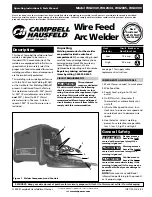
L-ACOUSTICS P Series Manual V2.1
7/12/2007
20
Note: When cabling your P Series loudspeaker for the first time, set the volume control fully counter-
clockwise (-∞). The input sensitivity of the 108P, 112P or SB15P can be matched to the output of the
mixing console (or other program source) by using the volume control on the rear panel.
The ferrite provided with your P series loudspeaker helps improve immunity to electromagnetic fields
(above 100 MHz) and should be placed on the XLR audio cable used for connecting input signal to
the 108P, 112P or SB15P. Perform a cable loop near the male XLR plug when attaching the ferrite.
3. APPLICATIONS
P Series loudspeakers are intended for portable distributed sound reinforcement, nearfield
monitoring (108P), floor monitoring or small- to medium-scale Front-Of-House (FOH) applications.
Guidelines for the use of P Series loudspeakers in these applications are discussed in this section.
3.1 AIMING P SERIES ENCLOSURES
Due to their controlled directivity behavior, P Series enclosures should be aimed so as to
geometrically cover the desired audience area with the main zero degree axis oriented towards the
middle or rear of the audience area. Since the wavefront radiated by an axi-symmetric sound source
has directivity that is smoothly increasing with frequency, this helps to match coverage, frequency
response and SPL to the acoustic environment of a typical auditorium (i.e., normally the
reverberation time in auditoria decreases smoothly above 1 kHz and at greater distances in the
venue, the low frequency energy is fairly constant due to the reverberant field).
Loudspeaker focus or aiming should be adjusted so that maximum HF energy is directed towards the
farthest listening areas – this helps to balance the SPL attenuation with distance that occurs in the
direct field. At closer listening positions, the off-axis attenuation at higher frequencies provides a
similar tonal balance and the overall SPL attenuation with distance is reduced.
Although P Series enclosures have controlled directivity attenuation properties it is important not to
have the first members of the audience too close to the system (i.e., in order not to produce
excessive sound pressure levels down front). Ideally, the ratio between the shortest and the furthest
distance covered should not exceed 1:4 and in order to obtain this throw distance ratio, it is often
desirable to fly the system. However, when P Series enclosures are flown and the audience seating
area begins very close to the stage, it is often necessary to use distributed front-fill speakers (for
example, 108P) or a stacked left/right 112P stereo infill system in order to improve coverage and
image localization for the first few rows of the audience.
90° opening angle
Figure 18: General guidelines for aiming P Series enclosures
Содержание 108P
Страница 1: ...Version 2 1 May 2007 L ACOUSTICS P SERIES 108P 112P SB15P OPERATOR MANUAL ...
Страница 31: ...L ACOUSTICS P Series Manual V2 1 7 12 2007 30 Figure 24 108P Line Drawing ...
Страница 32: ...L ACOUSTICS P Series Manual V2 1 7 12 2007 31 Figure 25 108P ETR8 2 Line Drawing ...
Страница 34: ...L ACOUSTICS P Series Manual V2 1 7 12 2007 33 Figure 26 112P Line Drawing ...
Страница 35: ...L ACOUSTICS P Series Manual V2 1 7 12 2007 34 Figure 27 112P ETR112XT Line Drawing ...
Страница 36: ...L ACOUSTICS P Series Manual V2 1 7 12 2007 35 Figure 28 112P XTLIFTBAR Line Drawing ...
Страница 38: ...L ACOUSTICS P Series Manual V2 1 7 12 2007 37 Figure 29 SB15P Line Drawing ...
Страница 39: ...L ACOUSTICS P Series Manual V2 1 7 12 2007 38 Figure 30 SB15P ETR15P Line Drawing ...
Страница 50: ...w w w l a c o u s t i c s c o m ...
Страница 76: ...w w w l a c o u s t i c s c o m ...
Страница 102: ...w w w l a c o u s t i c s c o m ...
Страница 103: ...w w w l a c o u s t i c s c o m ...
















































